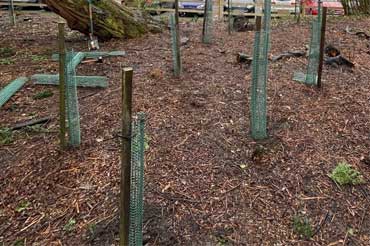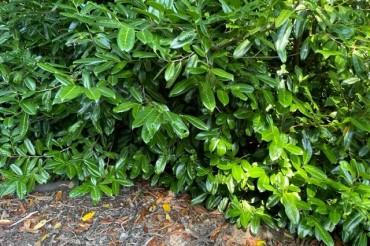We are working to improve the biodiversity value of woodland at South Hill Park.
The first stage of this project involved contractors removing invasive cherry laurel from a 0.25 hectare area of woodland.
This is a non-native, evergreen tree or shrub, which grows in the woodlands at South Hill Park.
The work took place in autumn 2023. We are installing fencing around this area to aid woodland recovery.

We have started follow up work to plant native trees.
| Attachment | Size |
|---|---|
| 1 MB |
Why we are doing this
The improvements are needed to maintain a healthy woodland environment.
Laurel grows in the woodlands at South Hill Park. It is a non-native, evergreen shrub and causes dense shade where it grows. The species is highly invasive and needs careful management to prevent it from dominating woodland.

Removing laurel from this area will make space for native broad leaved woodland species. These have higher biodiversity value.
This will keep the open character of the woodland and promote natural regeneration of the canopy and understorey species. In this way the woodland will function as a natural and dynamic system.
The improvements will help boost the routine management of the woodland and trees. These are carried out by the heritage parks team who look after the site.
These biodiversity improvements are also important for mitigating the impact of local developments. They will help to supply offsite biodiversity units for biodiversity net gain (BNG).
Rich tree heritage
It is important to preserve South Hill Park’s rich tree heritage, which extends back hundreds of years.
The site was once part of Windsor Forest, which was a royal hunting forest. The park was enclosed in the mid-17th century. Over the years it has been sculpted by the various owners, with trees planted, removed or being allowed to develop naturally.
Today, the trees and woodland are a significant feature of the site which need to be preserved and enhanced for future generations to enjoy.
Woodlands in decline
Woodlands are in decline across the UK, currently covering just 10% of our landscape. The average in mainland Europe is 40%.
In restoring the woodland areas at South Hill Park, we are working hard to improve the biodiversity of the area.
Work to restore native woodland will help:
- counteract the decline of native woodland species
- provide an important habitat for birds, bats, insects and mammals such as hedgehogs.
- support the development of wildlife corridors through Bracknell's urban environment
- improve local air quality by absorbing carbon dioxide and pollution
- support the council’s aims to becoming net zero by 2050
Precautions
When carrying out this type of woodland work, we take the following precautions:
- work takes place outside of bird nesting season
- the area is temporarily closed to keep you safe – visitors are advised to not cross any safety barriers
- site notices will tell you about the work
Funding the work
The work is being funded by section 106 local development money. This must be spent on new woodland creation or the enhancement of existing woodland within the council's area.
The funding has been earmarked for these improvements as they meet the above criteria.
It is also important for mitigating the impact of local developments. It will help to supply offsite biodiversity units for biodiversity net gain (BNG).
This will contribute to the recovery of nature while developing land. It is making sure the habitat for wildlife is in a better state than it was before development.
Find out more about new biodiversity net gain legislation on GOV.UK.
Future work
This is the first area lined up for improvements at South Hill Park. Further work is being planned in a phased approach over future years.
We will keep residents and visitors advised of when work is due to take place so they can better plan their visit.
